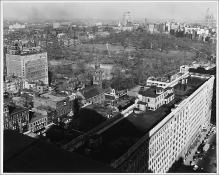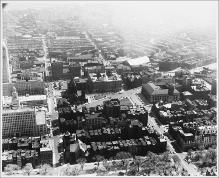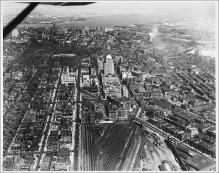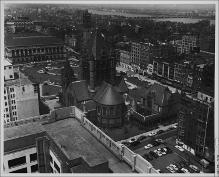Aerial View from John Hancock Building, Looking Northeast, Boston Common and Public Gardens, St. James Avenue and Arlington Street Church, State House in Background, 3:00 P.M.
Lynch, Kevin; Kepes, Gyorgy; Bichajian, Nishan

DownloadKL_000754_cp.jpg (690.3Kb)
Alternate file
Date
1954-1959Description
http://www.nps.gov/nr/travel/wash/dc68.htm
George Washington Parke Custis inherited the 1100-acre estate from his father, the only surviving son of Martha Washington. Like John Parke Custis, G.W.P. Custis was raised at Mount Vernon, and he dedicated much of his life to perpetuating the memory of George Washington.
He commissioned George Hadfield, the second architect of the US Capitol to design Arlington House. It was designed in 1818, and is the third representation of Greek Revival architecture in the United States. In 1803, Custis had constructed two wings, and Hadfield's design was erected between them. The house was constructed of locally made brick and its most prominent feature is the large 16' by 52' portico across the central section. The portico is formed by eight large stuccoed and marbleized brick Doric columns that support a massive central pediment. The house, sited prominently atop the hill, can be seen from many points in the District of Columbia.
Robert E. Lee, who was related to Custis's wife, was a frequent visitor to Arlington from childhood until his marriage to Custis's only daughter, Mary. For the next 30 years, the Lees considered Arlington their home. In the Lee bedroom on April 19, 1861, Lee made his fateful decision to resign his US Army commission rather than take up arms against his native state following Virginia's secession from the Union. On April 22, he left Arlington forever.
In 1863 Congress levied a tax on all confiscated properties, but payment was rejected for Arlington. It was put up for sale for non-payment of taxes in January of 1864 and purchased by the US government. In May 1864, Secretary of War Edwin Stanton ordered that a national cemetery be established at Arlington, and the first burials took place that month.
In 1928, following its authorization by Congress as a memorial to Lee, the house began to be restored by the War department. In 1933 the house and immediate grounds were transferred to the National Park Service. By that time, some structural changes made since 1861 had been reversed and many rooms had been partially furnished. Since, then further restoration has been completed.
Arlington House is located in Arlington, Va., just across Memorial Bridge from the Lincoln Memorial. Check with your ranger at the door to see if guided tours will be offered during your visit. In lieu of a free guided tour, self-guided tours and audio (cell phone) tours of the house will be available during your visit. Arlington House is open to visitors every day from 9:30 a.m. to 4:30 p.m., with the exception of January 1st and December 25th when the Arlington National Cemetery is also closed. Metro stop: Arlington Cemetery. full view
Type of Work
PhotographSubject
Boston (Mass.), City and town life, Massachusetts State House (Boston, Mass.), Massachusetts Institute of Technology, Urban areas, Land use, Urban, City planning, Urban planning and environment, Documentary photography, Rooftops, Aerial Views of Boston, (Boston, MA), Boston Common and Public Garden (Boston, MA), John Hancock Building (Boston, MA), Kepes/Lynch Photograph Collection, Arlington Street Church
Rights
Rights Statement
Creative Commons Attribution-NonCommercial 3.0 http://creativecommons.org/licenses/by-nc/3.0/
Item is Part of
135211
Metadata
Show full item recordCollections
Related items
Showing items related by title, author, creator and subject.
-
Aerial View Looking South, Copley Square, South End
Lynch, Kevin; Kepes, Gyorgy; Bichajian, Nishan (Repository: Rotch Visual Collections, Massachusetts Institute of Technology (Cambridge, Massachusetts, United States) ID: Kepes/Lynch Collection, 40.28, 1957) -
Aerial View from Plane, Looking East, Boylston Street to Intersection with Huntington Avenue, Large Rail Yard, John Hancock Building, Boston Skyline and Harbor in Background
Lynch, Kevin; Kepes, Gyorgy; Bichajian, Nishan (Repository: Rotch Visual Collections, Massachusetts Institute of Technology (Cambridge, Massachusetts, United States) ID: Kepes/Lynch Collection, 40.06, 1957) -
Copley Square from John Hancock Building
Lynch, Kevin; Kepes, Gyorgy; Bichajian, Nishan (Repository: Rotch Visual Collections, Massachusetts Institute of Technology (Cambridge, Massachusetts, United States) ID: Kepes/Lynch Collection, 12.35, 1954-1959)


